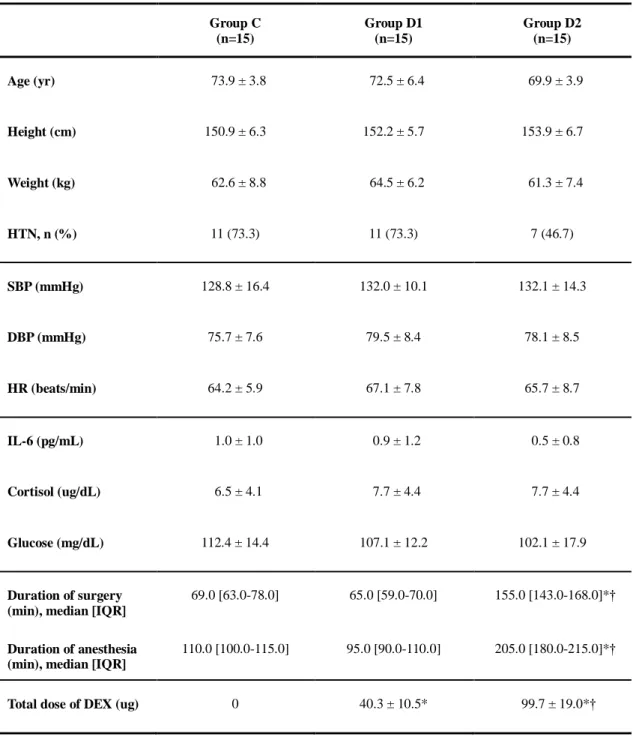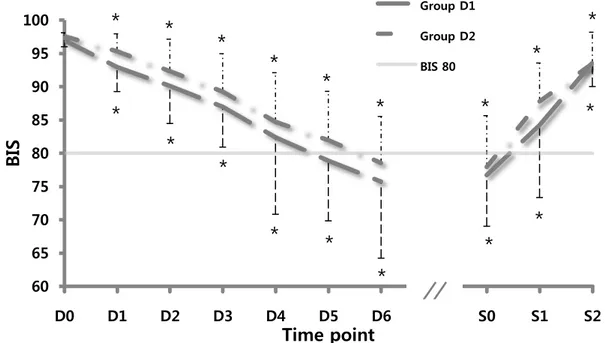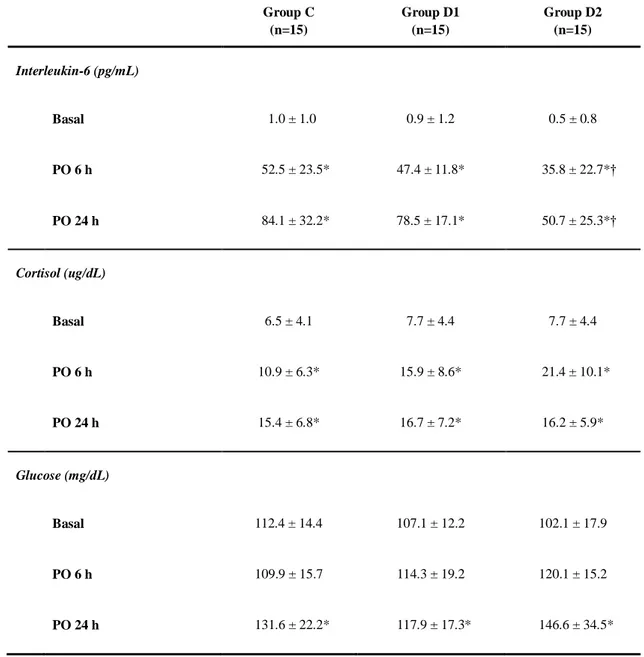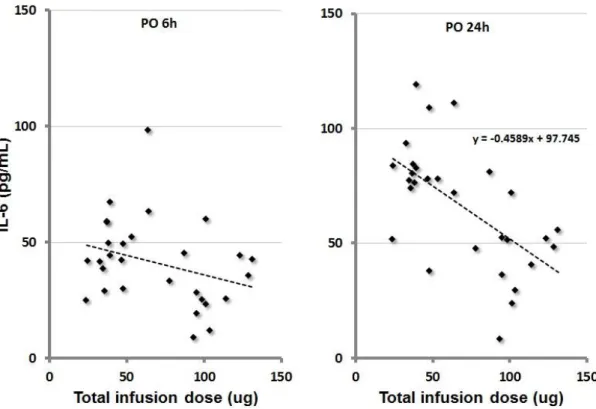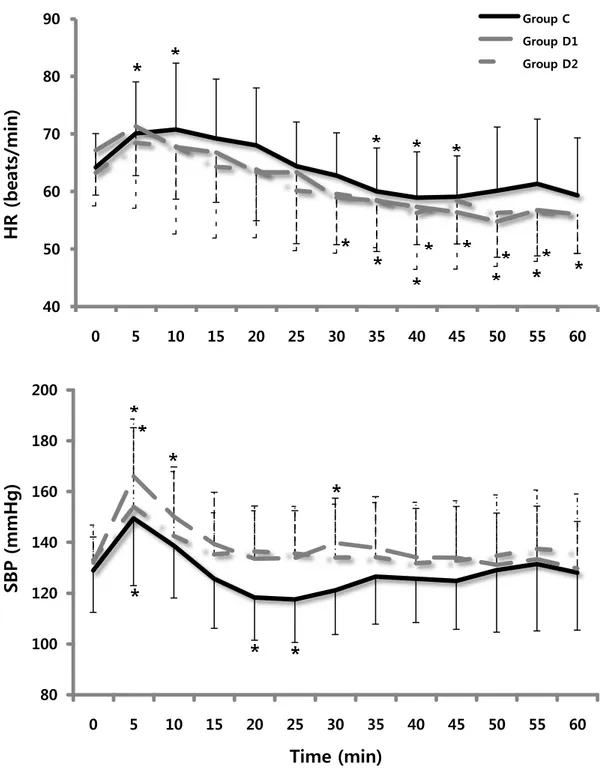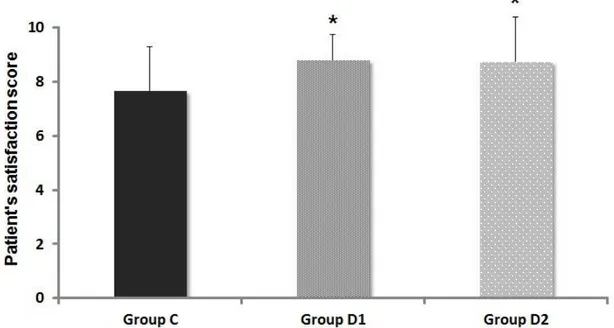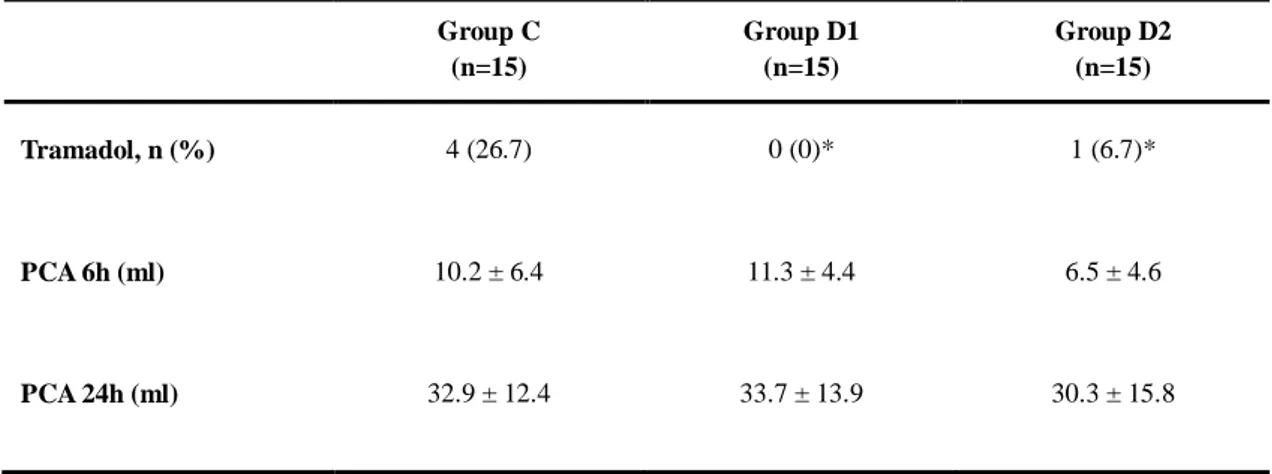저작자표시-비영리-변경금지 2.0 대한민국 이용자는 아래의 조건을 따르는 경우에 한하여 자유롭게 l 이 저작물을 복제, 배포, 전송, 전시, 공연 및 방송할 수 있습니다. 다음과 같은 조건을 따라야 합니다: l 귀하는, 이 저작물의 재이용이나 배포의 경우, 이 저작물에 적용된 이용허락조건 을 명확하게 나타내어야 합니다. l 저작권자로부터 별도의 허가를 받으면 이러한 조건들은 적용되지 않습니다. 저작권법에 따른 이용자의 권리는 위의 내용에 의하여 영향을 받지 않습니다. 이것은 이용허락규약(Legal Code)을 이해하기 쉽게 요약한 것입니다. Disclaimer 저작자표시. 귀하는 원저작자를 표시하여야 합니다. 비영리. 귀하는 이 저작물을 영리 목적으로 이용할 수 없습니다. 변경금지. 귀하는 이 저작물을 개작, 변형 또는 가공할 수 없습니다.
박사학위논문
척추마취 하에 무릎 전치환술을 받는 노인환자에서
dexmedetomidine의 스트레스 반응 경감, 혈역학적
안정성 및 수술 후 진통 효과
Effects of dexmedetomidine on stress hormone response,
hemodynamic stability and postoperative pain relief in
elderly patients undergoing total knee replacement
arthroplasty under spinal anesthesia
제주대학교 대학원
의학과
윤 소 희
Effects of dexmedetomidine on stress hormone response,
hemodynamic stability and postoperative pain relief in
elderly patients undergoing total knee replacement
arthroplasty under spinal anesthesia.
So Hui Yun, M.D.
(Supervised by professor Jong Cook Park)
June, 2014
Department of Anesthesiology and Pain Medicine
GRADUATE SCHOOL
Effects of dexmedetomidine on stress hormone response,
hemodynamic stability and postoperative pain relief in
elderly patients undergoing total knee replacement
arthroplasty under spinal anesthesia.
So Hui Yun, M.D.
(Supervised by professor Jong Cook Park)
A thesis submitted in partial fulfillment of the requirement for the degree of Master of
Medicine [Department of Anesthesiology and Pain medicine]
June, 2014
This thesis has been examined and approved.
Doctoral Committee:
Professor Chairman
Professor
Professor
Professor
Professor
Department of Anesthesiology and Pain Medicine
GRADUATE SCHOOL
1
Abstract
Background: The beneficial effects of dexmedetomidine (DEX) have not been extensively investigated in elderly patients receiving spinal anesthesia. This study evaluated the effects of intravenous DEX infusion on stress biomarkers, the hemodynamic response, and postoperative analgesia in elderly patients undergoing total knee replacement arthroplasty (TKRA).
Methods: We randomly allocated 45 adult American Society of Anesthesiologists(ASA) classification I–II patients undergoing elective TKRA under spinal anesthesia into 3 patient groups (n = 15 each); group C patients underwent unilateral TKRA without DEX administration, group D1 patients underwent unilateral TKRA with DEX administration, and group D2 patients underwent bilateral TKRA with DEX administration. In groups D1 and D2, DEX was initially infused at a concentration of 0.4 μg·kg-1·h-1 prior to anesthesia. After that time, the dose was adjusted to maintain 3 points on the Ramsay sedation score. Hemodynamic parameters were recorded intraoperatively at 5-min intervals. Serum interleukin-6 (IL-6), cortisol, and glucose concentrations were measured preoperatively, and at 6 and 24 h postoperatively. Postoperative patient satisfaction, pain scores, and analgesic requirements were also assessed.
Results: The preoperative serum IL-6 levels were 1.0 ± 1.0 pg/mL, 0.9 ± 1.2 pg/mL, and 0.5 ± 0.8 pg/mL in group C, group D1, and group D2, respectively. The serum IL-6 level was significantly lower in group D2 compared to in group C at 6 h (35.8 ± 22.7 pg/mL vs. 52.5 ± 23.5 pg/mL, respectively; p < 0.05) and 24 h (50.7 ± 25.3 pg/mL vs. 84.1 ± 32.2 pg/mL, respectively; p < 0.05). Bradycardia occurred more frequently in groups D1 and D2 compared to group C (33.3% and 53.3% vs. 6.7%, respectively; p < 0.05). The number of patients who required rescue analgesic drug was greater in group C than in groups D1 and
2
D2 at 6 h postoperatively (26.7% vs. 0% and 6.7%, respectively; p < 0.05). The patient satisfaction score was higher in groups D1 and D2 than it was in group C (8.8 ± 0.9 and 8.7 ± 1.7 vs. 7.7 ± 1.6, respectively; p < 0.05).
Conclusion: Perioperative intravenous DEX administration has a postoperative analgesic-sparing effect and increases patient satisfaction without serious complications in elderly patients undergoing TKRA under spinal anesthesia. In addition, long-term administration of perioperative DEX was associated with a decreased postoperative serum IL-6 level.
3
List of tables
Table 1. Demographic distribution and perioperative parameters. --- 14
Table 2. Comparison of serum interleukin-6, cortisol, and glucose among the 3 studied groups. --- 17
Table 3. Distribution of side effects. --- 23
4
Legend of figures
Figure 1. Intraoperative bispectral index (BIS) at 10-min intervals following intravenous dexmedetomidine administration. --- 15
Figure 2. Comparison of changes in serum interleukin-6 among the 3 studied groups. --- 18
Figure 3. Serum interleukin-6 concentration according to the total dexmedetomidine dose in patients receiving dexmedetomidine administration. A significant inverse correlation was observed between the total infusion dose of dexmedetomidine and serum interleukin-6 at 24 h postoperatively (r = -0.46, p < 0.01). --- 19
Figure 4. Intraoperative changes (5-min intervals) in heart rate and systolic blood pressure after intravenous infusion of dexmedetomidine. --- 21
5
Contents
Abstract --- 1 List of Tables --- 3 Legend of Figures --- 4 Introduction --- 6 Methods --- 8 Results --- 13 Discussion --- 25 Reference --- 326
Introduction
부위마취는 환자가 깨어있는 상태에서 자발호흡은 유지하면서 수술 부위의 통 증을 감쇄시켜 전신마취를 시행하지 않고도 효율적으로 수술이 가능한 마취 방 법이다. 그러나 부위마취로 수술 시 수술 기구로 인한 소음이나 술자들의 대화와 같은 외부 환경에 환자가 민감하게 반응할 수 있다. 수술이 길어질수록 환자는 장시간 같은 자세를 유지해야 하므로 이에 따른 불편감이 스트레스로 작용하기 도 한다. 따라서 부위마취를 시행한 후에는 적절한 진정상태를 유지하여 환자의 불안감을 감소시켜 줄 필요가 있다. 이와 더불어 진정을 유발하는 약물에 대한 연구도 활발히 진행되고 있다. 이전까지 진정제로 사용되던 약물들은 midazolam, propofol과 같이 대부분 GABA (gamma aminobutyric acid) 수용체 억제제이다. 이러한 약물들은 빠른 진정 과 회복을 특징으로 하지만 약물의 투여량에 따라 심혈관계 기능을 저하시키고 과진정 상태에서 호흡저하를 유발하는 등의 위험이 동반된다.1-5 또한 제통 효과 가 없기 때문에 필요할 경우 opioids를 병용해야 한다.6-8 반면 dexmedetomidine (DEX)은 주로 α2 -adrenergic 수용체에 작용하는 진정제로 알려져 있다. 1999년 FDA 승인을 받아 초기에는 중환자실 환자에서 24시간 이내 로 단기간 투여 시 진정 및 제통 효과를 얻기 위하여 사용되었다.9 이전까지 사 용되던 진정제와 다르게 적절한 진정을 유도하면서 호흡저하는 유발하지 않는 것을 특징으로 한다.10,11 뇌간의 청색반점(locus ceruleus)에 작용하여 정상 수면상 태와 비슷한 non-REM 수면을 유도하므로 환자는 편안한 상태를 유지하면서 인 지 및 기억 장애를 덜 유발하는 것으로 알려져 있다.12-14 중추신경계에 작용하여7 제통 효과를 나타내기도 하며,15 수술 중 발생하는 스트레스 관련 호르몬의 분비 를 감소시킨다는 보고도 있다.16 그러나 교감신경을 억제하는 효과가 있어 용량 에 따라 저명한 혈압저하, 서맥, 심박출량 감소를 유발할 수 있다.17-19 이전까지 DEX에 관한 연구들은 대부분 젊고 건강한 사람들을 대상으로 진행 되어 왔다. 호흡저하 없이 환자 협조가 가능한 진정 유도를 특징으로 감시하 마 취관리(monitored anesthesia care, MAC)에 유용한 것으로 보고되고 있다.6,12,20,21
전신 마취에서 강한 자극에 대한 혈역학적 반응을 안정적으로 유지하며 병용 시 마취 약제의 소요가 적은 이점도 있다.22,23 척추 마취 시 짧은 시간(90분 이내)의 수술 에 DEX 권장 부하용량을 주입하고 소량(0.2 ~ 0.25 μg·kg-1 ·h-1)의 유지용량 만으로 도 진정유지가 가능하다는 보고도 있다.1,24 DEX을 정맥으로 주입할 경우 척추마 취의 기간을 연장시키고 술후 제통작용이 있다는 연구가 진행된 바 있다.25,26 그 러나 부위마취로 수술을 받는 노인 환자에서 수술 중 혈역학적 안정을 유지하며 수술 후 스트레스 반응과의 관계를 볼 수 있는 지표를 제시한 연구는 없다. 본 연구는 노인환자에서 척추마취로 무릎 전치환술 시 DEX을 진정약물로 사 용할 때 약물에 의한 혈역학적 변화와 진정상태를 관찰하고, DEX이 수술 후 스 트레스 반응을 경감시키고 제통 작용을 유도하여 회복과정에도 유리한 약물인지 알아보고자 한다.
8
Materials and methods
본 연구는 제주대학교병원 의학연구윤리심의위원회의 승인을 받은 연구계획서에 따라 진행되었다. (IRB No.2013-05-012)
1. Patients
ASA (American society of anesthesiologists physical state) 분류상 I–II의 성인에서 정 규 수술로 척추마취 하에 무릎 전치환술을 받는 환자 총 45명을 대상으로 하였 다. 단, 당뇨, 심한 심혈관계 질환, 스테로이드 복용력, 신기능 또는 간기능 저하, 정신지체가 있는 환자 혹은 수술 전 저혈압이나 저혈량증을 보이는 환자는 연구 대상에서 제외시켰다. 2. Group assessment 총 45명의 환자를 대상으로 15명씩 3개의 군에 임의로 배정하였다. 1) Group C: 편측 무릎 수술 중 생리식염수를 주입하는 군 (15명) 2) Group D1: 편측 무릎 수술 중 DEX을 주입하는 군(0.4 ~ 0.8 μg·kg-1·h-1, 15명) 3) Group D2: 양측 무릎 수술 중 DEX을 주입하는 군(0.4 ~ 0.8 μg·kg-1·h-1, 15명)
9 3. Anesthetic regimen 모든 환자들은 수술 전투약 없이 수술실에 입실하며 비침습적 혈압계, 심전도 와 산소포화도를 거치하여 퇴실할 때까지 5분 간격으로 활력징후를 기록하였다. 초기 활력징후를 측정한 후, 척추마취 전 D1과 D2군은 진정약물인 DEX을 부하 용량 없이 초기 용량인 0.4 μg·kg-1 ·h-1으로 주입하면서 산소 5 L/min을 마스크로
공급하고 진정 상태를 감시하기 위하여 BIS (bispectral index)를 모니터 하였다. C 군은 동량의 생리식염수를 주입하며 산소를 공급하였다. 척추마취는 혈관 내에 링거젖산용액 400ml로 수분공급을 한 뒤, 요추 4-5번 사 이 공간에서 시행하되 이 부위에서 접근이 어려울 경우 요추 3-4번 사이 공간에 서 시행하였다. 척수강 내에 약물을 주입하고 마취레벨이 피부분절 T10 이상으로 도달하면 수술을 진행하였다. 마취 후 활력징후가 안정되면 지속적으로 수술 중 혈압, 맥박, 산소포화도, 호 기말 이산화탄소 그래프를 관찰하며 부작용 및 추가 약물 투여 여부를 기록하였 다. 만약 진정상태에서 20초 이상 호기말 이산화탄소가 검출되지 않으면 무호흡 이 있는 것으로 정의하고 환자에게 자극을 주었다. 혈압 변화는 수축기 혈압을 기준으로 기저치의 20% 이내로 유지하여 이보다 낮거나 또는 수축기 혈압이 90 mmHg 이하의 저혈압이 발생한 경우는 ephedrine 5mg을 정주하였다. 서맥은 심박 수가 50회/분 이하일 경우로 정의하고 서맥이 발생한 경우에는 atropine 0.5mg이나 glycopyrrolate 0.2mg을 정주하였다. D1과 D2군에서 수술 중 DEX 주입 용량은 Ramsay sedation score (RSS) 에 따라 3점(별첨 1)을 유지하는 용량으로 조절하고 수술이 종료되면 약물 투여를 중단하였다.
10
Appendix 1. The evaluation quality of sedation was based on a six-point Ramsay sedation score. 27
Score Response
1 Anxious, agitated or restless or both
2 Cooperative, oriented, tranquil alert
3 Responding to commands only
4 Brisk response to light glabellar tap or loud auditory stimulus
5 Sluggish response to light glabellar tap or loud auditory stimulus
6 No response
회복 중에는 마취에 대한 환자의 만족도를 점수화(최저 0부터 최고 10점)하여 평가한 후, 마취레벨이 피부분절 T12 이하로 내려가고 기타 특이 증상이 없으면 수술 중 마취에서 회복된 것으로 판단하여 병동으로 전실하였다. 수술 후 통증조 절을 위하여 자가통증조절장치는 fentanyl 10mcg/kg, ketorolac 300mg과 항구역약제 를 섞어 총 100 ml 용량을 만들어 basal infusion rate은 1.0 ml, bolus 1.0 ml, 락아웃 (lockout) 시간을 15분으로 만들어 제공하였다. 병동에서는 시각통증등급 (visual analogue scale, VAS)을 이용하여 수술 후 통증을 평가하였다. 자가통증조절장치만 으로 통증 조절이 불완전하여 환자가 시각통증등급 5 이상의 통증 호소 시 진통 제인 tramadol 50mg을 1회 정주하고 이를 기록하였다.
11 4. Measurements 혈역학적 변수인 혈압, 맥박, 산소포화도, 호기말 이산화탄소분압은 수술 중 지속적으로 측정하여 5분 단위로 기록하였다. D1과 D2군에서는 진정 상태를 수치화하기 위하여 수술 중 BIS로 감시하면서 10분 간격으로 기록하였다. 스트레스 호르몬 반응은 혈중 IL-6, 코티솔, 포도당 수치의 3가지 요소를 관찰하였다. 측정은 수술 전, 수술 후 6시간, 수술 후 24시간에 걸쳐 총 3회 혈액을 채취하여 수술 전 측정치를 기저치로 수술 후 시간에 따른 변화를 비교하였다. 수술 후 통증 반응은 수술 후 6시간과 24시간에 주입된 자가통증조절장치의 총 양을 기록하고, 수술 후 6시간 이내에 추가로 진통제가 투여 되었는지 여부를 기록하였다.
* IL-6의 측정: Enzyme-linked immunosorbent assay (ELISA) – Human IL-6 Quantikine ELISA kit (R&D system, St. Louis, MO, USA)를 사용하여 환자의 혈청 중 interleukin-6 (IL-interleukin-6) 양을 측정하였다. 표준곡선(standard curve)을 그리기 위하여 kit에 포함된 human IL-6를 300과 100 pg/mL에서부터 1/2 씩 순차적으로 희석하였다(serial dilution). 먼저 Coating plate의 각 well에 희석액(RD1W)을 100 μL 씩 분주하였다. 다음 환자들의 혈청 또는 Standard 시료를 각각의 well에 100 μL 씩 첨가하고 상온에서 2시간 방치하였다. Washing Buffer (400 μL)를 각 well에 채운 후 버리는 방식으로 4회 반복하였다. IL-6 conjugate antibody를 각 well에 200 μL 씩 분주하고 상온에서 2시간 동안 방치하였다. Washing Buffer (400 μL)를 각 well에 채운 후 버리는 방식으로 4회 반복하였다. 그 다음, 각 well에 Substrate solution을 200 μL 씩 분주하고 어두운 곳의 상온에서 20분 동안 방치하였다. 다음 Stop solution을
12
각 well에 100 μL 씩 첨가하여 반응을 정지시키고, 450 nm 파장에서 VersaMax ELISA microplate reader로 optical density를 측정하여 결과를 분석하였다. 혈청과 표준곡선 측정에 있어서 n은 2(duplicate)로 하였다. 5. Analysis 기존 연구에서 DEX을 주입한 군과 비교하여 대조군에서의 IL-6 측정치는 수술 후 6시간에 평균 34.75 pg/mL 상승하였고 표준편차는 11.97 이었다.16 IL-6는 4~6시 간에 최대로 상승하는 지표이므로 수술 후 6시간의 상승치가 기존의 연구와 비 슷하다고 가정하여 약물 투여군의 시간에 따른 반응을 비교하고자 하였을 때 alpha error 0.05와 beta error 0.2에서 필요한 표본수는 군당 15명이다.
데이터는 SPSS (IBM SPSS statistics 21 for Windows)를 이용하여 분석하였다. 연속
형 범주자료 중 정규성 분포 자료는 평균 ± 표준편차로, 비정규성 분포 자료는
중앙값 [25% – 75%]으로 나타내고 그룹간 비교는 Kruskal-Wallis test와 Mann-Whitney test를 사용하였다. 부작용 발생 유무와 같은 비연속형 범주의 자료는 Fisher’s exact test를 하였다. 기저치와 비교하여 변화된 값은 Wilcoxon signed rank test를 시행하고, 시간에 따른 혈역학적 변수와 스트레스 반응치는 repeated measured ANOVA를 사용하여 검정하였다. p < 0.05인 값들을 유의하다고 판단하였 다.
13 Results 세 군 간의 인구학적 통계 결과 환자군은 평균 70세 이상(C군: 73.9 ± 3.8, D1군: 72.5 ± 6.4, D2군: 69.9 ± 3.9)으로 군 간의 차이는 없었다. 또한 키, 몸무게, 고혈 압 유무, 혈역학적 변수 및 스트레스 반응 표지자의 기저치 등에서 유의한 차이 를 보이는 변수는 없었다(표1). 수술시간은 C군 69.0분 [63.0 – 78.0], D1군 65.0분 [59.0 – 70.0], D2군 155.0분 [143.0 – 168.0]이었고 마취시간은 C군 110.0분 [100.0 – 115.0], D1군 95.0분 [90.0 – 110.0], D2군 205.0분 [180.0 – 215.0]으로 D2군에서 다른 군들에 비해 유의하게 수술 및 마취 시간이 길었다(p < 0.05). DEX의 총 투여량은 D1군에서 40.3 ± 10.5 μg, D2군에서 99.7 ± 19.0 μg으로 D2군이 유의하게 많은 양이 투여되었다(p < 0.05). D군에서는 진정 상태를 객관화하기 위하여 시간에 따른 BIS 변화를 10분 간격 으로 관찰하여 약물주입을 시작한 시점과 중단한 시점을 기준으로 그래프로 나 타내었다(그림 1). BIS 수치가 80이하로 감소하는데 평균 D1군 47.7분, D2군 57.4 분이 소요되었다. 각 군의 초기값을 기준으로 유의한 변화를 보이는 값들은 별표 (*)로 표시하였다. 약물 중단 이후 BIS가 80 이상으로 회복되는 데에는 평균 D1 군 4.3분, D2군 1.8분이 소요되었다. 약물 투여 이후부터 약물 중단 후 20분까지 모든 구간에 걸쳐 D1군과 D2군 사이의 BIS 수치 상 통계학적 유의한 차이는 없 었다.
14
Table 1. Demographic distribution and perioperative parameters.
Group C (n=15) Group D1 (n=15) Group D2 (n=15) Age (yr) 73.9 ± 3.8 72.5 ± 6.4 69.9 ± 3.9 Height (cm) 150.9 ± 6.3 152.2 ± 5.7 153.9 ± 6.7 Weight (kg) 62.6 ± 8.8 64.5 ± 6.2 61.3 ± 7.4 HTN, n (%) 11 (73.3) 11 (73.3) 7 (46.7) SBP (mmHg) 128.8 ± 16.4 132.0 ± 10.1 132.1 ± 14.3 DBP (mmHg) 75.7 ± 7.6 79.5 ± 8.4 78.1 ± 8.5 HR (beats/min) 64.2 ± 5.9 67.1 ± 7.8 65.7 ± 8.7 IL-6 (pg/mL) 1.0 ± 1.0 0.9 ± 1.2 0.5 ± 0.8 Cortisol (ug/dL) 6.5 ± 4.1 7.7 ± 4.4 7.7 ± 4.4 Glucose (mg/dL) 112.4 ± 14.4 107.1 ± 12.2 102.1 ± 17.9 Duration of surgery (min), median [IQR]
69.0 [63.0-78.0] 65.0 [59.0-70.0] 155.0 [143.0-168.0]*†
Duration of anesthesia (min), median [IQR]
110.0 [100.0-115.0] 95.0 [90.0-110.0] 205.0 [180.0-215.0]*†
Total dose of DEX (ug) 0 40.3 ± 10.5* 99.7 ± 19.0*†
Group C: unilateral total knee replacement arthroplasty without dexmedetomidine administration, Group D1: unilateral total knee replacement arthroplasty with dexmedetomidine administration, Group D2: bilateral total knee replacement arthroplasty with dexmedetomidine administration. HTN: hypertension, SBP: systolic blood pressure, DBP: diastolic pressure, HR: heart rate, IL-6: interleukin-6, IQR: interquartile range, DEX: dexmedetomidine. Data are presented as mean ± SD or median [IQR]. *p < 0.05 vs. group C, †p < 0.05 vs. group D1.
15
Figure 1. Intraoperative bispectral index (BIS) at 10-min intervals following intravenous dexmedetomidine administration. Group D1: unilateral total knee replacement arthroplasty with dexmedetomidine administration, Group D2: bilateral total knee replacement arthroplasty with dexmedetomidine administration. D0: initial dexmedetomidine administration, S0: dexmedetomidine administration completion. Data are presented as the mean ± SD. *p < 0.05 vs. baseline within group.
60 65 70 75 80 85 90 95 100 D0 D1 D2 D3 D4 D5 D6 S0 S1 S2
BI
S
Time point
Group D1 Group D2 BIS 80*
*
*
*
*
*
*
*
*
*
*
*
*
*
*
*
*
*
̸ ̸
16 DEX을 사용한 군에서 스트레스 반응을 보는 혈액검사 결과 IL-6와 코티솔 측 정치는 수술 전 기저치와 비교하여 시간의 변화에 따라 군 내에서 각각 유의한 차이를 보였다(p < 0.05). 포도당은 기저치와 비교해서 수술 후 24시간 측정치를 제외하고 군내, 군간 모두 유의한 차이를 보이지 않았다(표 2). 편측 무릎 수술이 이루어진 C군과 D1군에서는 수술 후 6시간과 24시간의 IL-6 측정치가 각각 52.5 ± 23.5 pg/mL, 84.1 ± 32.2 pg/mL 과 47.4 ± 11.8 pg/mL, 78.5 ± 17.1 pg/mL으로 시간에 따른 군 간 통계학적 유의성은 없었다. 그러나 D2군의 수술 후 6시간, 24시간 측 정치는 35.8 ± 22.7 pg/mL, 50.7 ± 25.3 pg/mL으로 C군과 비교하여 군 간에도 유의한 차이를 보였다(p < 0.05, 그림 2).
17
Table 2. Comparison of serum interleukin-6, cortisol, and glucose among the 3 studied groups.
Group C: unilateral total knee replacement arthroplasty without dexmedetomidine administration, Group D1: unilateral total knee replacement arthroplasty with dexmedetomidine administration, Group D2: bilateral total knee replacement arthroplasty with dexmedetomidine administration. Basal: preoperative serum level, PO 6 h and 24 h: postoperative 6 h and 24 h. Data are presented as the mean ± SD. *p < 0.05 vs. baseline within group. †p < 0.05 vs. Group C. Group C (n=15) Group D1 (n=15) Group D2 (n=15) Interleukin-6 (pg/mL) Basal 1.0 ± 1.0 0.9 ± 1.2 0.5 ± 0.8 PO 6 h 52.5 ± 23.5* 47.4 ± 11.8* 35.8 ± 22.7*† PO 24 h 84.1 ± 32.2* 78.5 ± 17.1* 50.7 ± 25.3*† Cortisol (ug/dL) Basal 6.5 ± 4.1 7.7 ± 4.4 7.7 ± 4.4 PO 6 h 10.9 ± 6.3* 15.9 ± 8.6* 21.4 ± 10.1* PO 24 h 15.4 ± 6.8* 16.7 ± 7.2* 16.2 ± 5.9* Glucose (mg/dL) Basal 112.4 ± 14.4 107.1 ± 12.2 102.1 ± 17.9 PO 6 h 109.9 ± 15.7 114.3 ± 19.2 120.1 ± 15.2 PO 24 h 131.6 ± 22.2* 117.9 ± 17.3* 146.6 ± 34.5*
18
Figure 2. Comparison of changes in serum interleukin-6 among the 3 studied groups. Group C: unilateral total knee replacement arthroplasty without dexmedetomidine administration, Group D1: unilateral total knee replacement arthroplasty with dexmedetomidine administration, Group D2: bilateral total knee replacement arthroplasty with dexmedetomidine administration.PO 6 h and 24 h: postoperative 6 h and 24 h. *p < 0.05 vs. group C. 0 20 40 60 80 100 120 Basal PO 6h PO 24h
IL
-6
(p
g/mL
)
Time point
Group C Group D1 Group D2*
*
19 수술 중 DEX의 전체 투여량에 따른 IL-6의 변화를 관찰하였을 때 수술 후 6시 간에는 용량에 따라 음의 상관관계를 보였으나 유의성은 없었다(그림 3). 그러나 수술 후 24시간에서 약물 투여량과 IL-6 사이의 유의한 음의 상관성을 보였다(r = -0.46, p < 0.01). 이는 아래와 같은 수식으로 나타낼 수 있다. IL– 6 = −0.4589 × DXM dose + 97.745 (식 1)
Figure 3. Serum interleukin-6 concentration according to the total dexmedetomidine dose in patients receiving dexmedetomidine administration. A significant inverse correlation was observed between the total infusion dose of dexmedetomidine and serum interleukin-6 at 24 h postoperatively (r = -0.46, p < 0.01). PO 6 h and 24 h: postoperative 6 h and 24 h in group of dexmedetomidine administration.
20 혈역학적 변화를 보기 위하여 혈압과 맥박수를 관찰한 결과 세 군간의 유의한 차이는 없었다. 수축기 혈압의 경우, 약물 주입 5분 후 세 군 모두에서 일시적으 로 상승하였다가 C군에서 평균값이 가장 낮게 유지되었다. 맥박수의 기저치는 D1군에서 높았으나 수술 중에는 C군에 비하여 D1, D2군이 낮게 유지되었고 군 간 유의한 차이는 없었다(그림 4). 또한 D2군에서 맥박수는 DEX 주입 후 40분부 터 약 30분간 기저치에 비하여 유의하게 감소한 채로 유지되다가 이후 DEX 주 입을 지속하더라도 추가약물 투여 없이 기저치로 회복되는 양상을 보였다. 환자의 수술 중 마취에 대한 만족도의 평균은 C군 7.7 ± 1.6점, D1군 8.8 ± 0.9점, D2군 8.7 ± 1.7점으로 약물을 투여 받은 D1군과 D2군에서 유의하게 만족도가 높 았다(p < 0.05, 그림 5). 약물 주입과 관련된 부작용에서 세 군 모두 무호흡은 관찰되지 않았다(표 3). 저혈압은 세 군 모두에서 각각 2명(13.3%)으로 유의한 차이를 보이지 않았으나, 서맥은 C군(1명, 6.7%)에 비하여 D1군(5명, 33.3%)과 D2군(8명, 53.3%)에서 유의하 게 많이 발생하였다 (p < 0.05). 약물의 제통 효과를 알아보기 위하여 자가통증조절장치를 통한 진통제의 투여 용량을 비교하였을 때 세 군에서 수술 후 6시간(C군: 10.2 ± 6.4 ml, D1군: 11.3 ± 4.4 ml, D2군: 6.5 ± 4.6 ml)과 24시간(C군: 32.9 ± 12.4 ml, D1군: 33.7 ± 13.9 ml, D2군: 30.3 ± 15.8 ml) 모두 유의한 차이가 없었다(표4). 반면 수술 후 6시간 이내에 추가 진통 제 투여 여부를 비교해 본 결과 D1군은 추가 투약 환자가 없었고, D2군에서 1명 (6.7%)에 비하여 C군은 4명(26.7%)의 환자가 추가로 진통제를 투여 받았다 (p < 0.05).
21
Figure 4. Intraoperative changes (5-min intervals) in heart rate and systolic blood pressure after intravenous infusion of dexmedetomidine. Group C: unilateral total knee replacement arthroplasty without dexmedetomidine administration, Group D1: unilateral total knee replacement arthroplasty with dexmedetomidine administration, Group D2: bilateral total knee replacement arthroplasty with dexmedetomidine administration. Data are presented the mean ± SD. *p < 0.05 vs. baseline within group.
40 50 60 70 80 90 0 5 10 15 20 25 30 35 40 45 50 55 60
H
R
(b
eat
s/m
in
)
Group C Group D1 Group D2 80 100 120 140 160 180 200 0 5 10 15 20 25 30 35 40 45 50 55 60SBP
(mm
H
g)
Time (min)
22
Figure 5. Comparison of patient satisfaction among the 3 studied groups. Group C: unilateral total knee replacement arthroplasty without dexmedetomidine administration, Group D1: unilateral total knee replacement arthroplasty with dexmedetomidine administration, Group D2: bilateral total knee replacement arthroplasty with dexmedetomidine administration. *p < 0.05 vs. group C.
23 Table 3. Distribution of side effects.
Group C (n=15) Group D1 (n=15) Group D2 (n=15) Apnea, n (%) 0 (0) 0 (0) 0 (0) Hypotension, n (%) 2 (13.3) 2 (13.3) 2 (13.3) Bradycardia, n (%) 1 (6.7) 5 (33.3)* 8 (53.3)*
Group C: unilateral total knee replacement arthroplasty without dexmedetomidine administration, Group D1: unilateral total knee replacement arthroplasty with dexmedetomidine administration, Group D2: bilateral total knee replacement arthroplasty with dexmedetomidine administration. Data are presented as the number of patients (percentage). *p < 0.05 vs. group C.
24
Table 4. Comparison of analgesic effects among the 3 studied groups.
Group C (n=15) Group D1 (n=15) Group D2 (n=15) Tramadol, n (%) 4 (26.7) 0 (0)* 1 (6.7)* PCA 6h (ml) 10.2 ± 6.4 11.3 ± 4.4 6.5 ± 4.6 PCA 24h (ml) 32.9 ± 12.4 33.7 ± 13.9 30.3 ± 15.8
Group C: unilateral total knee replacement arthroplasty without dexmedetomidine administration, Group D1: unilateral total knee replacement arthroplasty with dexmedetomidine administration, Group D2: bilateral total knee replacement arthroplasty with dexmedetomidine administration. PCA 6 h and 24 h: total volume infused via patient-controlled analgesia during 6 h postoperatively and 24 h postoperatively, respectively. Data are presented as the mean ± SD. *p < 0.05 vs. group C.
25 Discussion 본 연구에서 스트레스 반응을 보기 위한 지표로 IL-6는 수술 후 24시간에 DEX 의 전체 투여량과 유의한 음의 상관관계가 있음을 알 수 있었다. DEX 투여 후 약 52분부터 BIS 80 이하로 감소하여 DEX를 중단한 이후에는 이전 주입량과 무 관하게 D1, D2 환자군 모두에서 비슷한 양상으로 BIS 값이 빠르게 회복되는 것 을 관찰할 수 있었다. 또한 DEX 투여 군에서 환자의 만족도가 높았으며 투여 기 간을 증가시키더라도 이와 연관된 두드러진 혈압 저하는 없었다. IL-6는 수상 후 60분부터 검출이 가능하고 4 ~ 6시간에 최대로 상승하며 10일 까지 지속적으로 검출되는 사이토카인이다.28 사이토카인이 분비되는 염증전 반 응(pro-inflammatory response)은 병적인 상태에만 한정되지 않고 건강한 성인에서 도 급성 심리적 스트레스가 일시적으로 말초의 사이토카인 생산을 증가시킬 수 있다고 알려져 있다.29,30 특히 스트레스에 의하여 유발되는 IL-6의 상승은 분노, 불안의 감정과 양의 상관관계를 보인다.31 따라서 IL-6 측정치가 약물의 전체 투 여량에 따라 차이가 나는지 확인하기 위하여 약물 투여군을 편측 수술한 환자군 (D1)과 양측 수술한 환자군(D2)으로 나누어 비교하였다. 그 결과 C군과 D1군 간 에는 유의한 차이가 없었으나 C군을 기준으로 D2군에서 IL-6가 수술 후 6시간, 24시간에 통계적으로 유의한 차이를 보였다(그림 2). 또한 D1군과 D2군은 투여된 DEX의 총량에서 차이가 있으므로 전체 투여된 DEX 양에 따라 IL-6 변화를 관 찰하였을 때 수술 후 24시간의 IL-6의 변화는 ‘식 1’과 같은 음의 함수를 보이며 유의하게 감소하는 양상을 보여 스트레스 반응을 감소시키는 것으로 생각할 수 있다(그림 3).
26 스트레스 반응의 경감 여부는 IL-6, 코티솔, 포도당의 기저치에 비하여 수술 후 상승양상을 세 군에서 비교 관찰하였다. IL-6는 손상 부위에 대한 염증반응의 면 역 매개체인데 일차적으로 손상에 의하여 생성이 촉진될 수도 있지만 전반적인 혈역학적 불안정이나 대사과정의 손상에 의해서도 생성이 촉진될 수 있다.28,32 또 한 스트레스 상황에서 시상하부가 자극되어 ACTH가 분비되고 이는 초기 코티솔 의 상승으로 전환되어 포도당, 아미노산, 지방산의 대사를 증가시키게 된다.33 따 라서 기저치와 수술 후 변수 간의 수치변화를 비교해 봄으로써 스트레스 반응에 대한 평가가 가능할 것으로 예상하였다. 이전 연구에서는 대조군이 기저치의 2배 이상 상승하는 결과를 보인 반면 투 약군에서 IL-6가 기저치 8.85 pg/mL에서 수술 후 1일에 9.73 pg/mL로, 코티솔이 12.33 μg/dL에서 15.39 μg/dL로, 포도당이 96.47 mg/dL에서 98.27 mg/dL로 거의 상 승하지 않은 것을 볼 수 있다.16 중환자실 환자를 대상으로 IL-6가 기저치 430 pg/mL에서 DEX 주입 후 212.4 pg/dL까지 감소하는 연구도 보고된 바 있다.34 이 와는 달리 DEX를 주입한 군에서 스트레스 반응은 대조군에 비하여 큰 변화가 없었다는 보고도 있다.35,36 본 연구에서 세가지 지표 모두 통계상 시간 경과에 따 른 교호반응을 보이지 않는 것으로 나타났다(표 2). 코티솔 수치는 일반적으로 일일 주기를 보임에도 불구하고 검체 채취 시점이 수술 끝나는 시간을 기준으로 하였다. 이로 인하여 환자마다 오전 혹은 오후의 서로 다른 시간대 측정값 평균 을 비교하여 오류를 유발했을 가능성이 있다. 포도당은 투약군에서 시간이 지남 에 따라 상승하였는데 이는 α2 receptor가 뇌와 척수뿐만 아니라 혈관과 다른 평 활근에도 작용하기 때문에 췌장에서 인슐린 분비를 저하시켜 포도당 수치가 상 승하였을 수 있다.9 또한 척추 마취가 된 상태이므로 수술 중 통증에 의한 스트
27
레스 자극이 적었고 DEX의 투여 용량 자체가 유의한 결과를 얻기에는 적은 용 량이 투여되어 Il-6를 제외한 스트레스 반응 수치가 유의하지 않은 결과로 나타 났을 수 있다.
DEX 주입에 따른 BIS 값의 변화를 보면 이전 연구에서는 주입 후 BIS가 80 이하로 하강하는데 약 10분(부하용량 1 μg/kg를 10분에 걸쳐 주입)이 소요되었 다.1,37 그러나 본 연구에서는 초기 부하용량을 투여하지 않았기 때문에 DEX 주 입 후 BIS의 수치가 80 이하로 하강하는 데에 약 52분이 소요되었다. DEX의 작 용 시간은 약물 정주 후 15분이 소요되며 지속정주 할 경우 최고농도에 달하는 데에는 1시간 가량이 소요된다. 분포 반감기(distribution half-life)는 6분이며 최종 제거 반감기(terminal elimination half-life)는 2 ~ 2.5시간으로 알려져 있다. 38
약물 작 용에 시간이 걸리기 때문에 초기 부하용량으로 1 μg/kg을 10분에 걸쳐 주입하고 이후 0.2 ~ 1.0 μg·kg-1 ·h-1의 용량으로 적절한 진정상태를 유지하는 것을 권장(단, 65세 이상의 노인환자나 자극이 적은 눈 부위의 수술 혹은 간기능 저하가 있는 환자에서는 용량을 줄이는 것을 권고)한다.39 그러나 부하용량 없이 소량(0.4 ~ 0.8 μg·kg-1 ·h-1)의 DEX를 이용하더라도 20분 이내에 BIS 80 ~ 90의 얕은 진정상태가 유지되었다. 수술이 길어질수록 투여되는 약물의 총량도 증가하게 되는데 수술시 간에서 확연한 차이를 보이는 D1군과 D2군을 비교하였을 때, DEX가 투여된 총 량과 무관하게 약물주입 중단 후 군간의 통계적 차이 없이 BIS의 수치가 비슷한 양상으로 빠르게 상승하는 것을 관찰 할 수 있었다(그림 2). DEX의 약역학상 상 황민감성 반감기(context-sensitive half-time)가 명확하게 정의된 바는 없다. Iirola 등 에 따르면 중환자실의 환자를 대상으로 여러 가지 모델에 따라 모의실험을 해본
결과 대부분의 모델에서 60세를 기준으로 부하용량 3 ~ 6 μg·kg-1
28 입하고 지속용량으로 0.1 ~ 2.5 μg·kg-1 ·h-1로 2시간 이상 지속 정주할 경우, 60분 이 상의 상황민감성 반감기를 보였다.40 또한 고령일수록 청소율이 감소하기 때문에 이를 고려할 필요가 있다고 하였다. 그러나 이와는 달리 본 연구에서는 약물 주 입 중단과 함께 빠른 시간 안에 환자가 협조 가능할 정도로 회복되는 결과를 보 였다. 이는 아마도 용량의존적 진정효과가 있기 때문에 장시간 DEX을 사용한 중 환자실 환자와 비교하여 회복하는 시점에서의 BIS 수치(60 ~ 80의 증등도 진정상 태)와 약물의 용량이 영향을 미쳤을 것으로 생각된다.41 따라서 DEX은 부하용량 없이 환자가 가장 편안한 정도의 진정이 유지되는데 까지 일정 시간이 필요하게 되는데, BIS를 기반으로 평가하면 편측 수술인 경우에는 수술시간이 짧기(평균 67.0분) 때문에 오히려 120분 이상이 소요되는 양측 수술(평균 155.0분)에서 유용 하게 사용할 수 있는 진정 약물로 생각된다. DEX은 교감신경계억제 작용으로 혈압과 심박수를 저하시킨다.9,17,19,20 용량의존 적으로 말초혈관의 alpha-2b 수용체에 작용하여 혈관수축을 유도하므로 혈관이완 (central sympatholytic alpha-2a)과 혈관수축 (peripheral vascular alpha-2b)에 대하여 경 쟁적으로 작용 한다. 그 결과 초기 투여 후 일시적으로 약물의 혈장농도가 높아 지면 고혈압이 나타났다가 약물이 빠르게 재분포 되면서 교감신경의 tone이 감쇄 한다. 본 연구에서는 약물의 혈역학적 영향을 관찰하기 위하여 혈압과 맥박 두 가지 변수의 변화를 비교하였다. 혈압 변화는 기저치의 20% 이상 감소하거나 수 축기 혈압이 90 mmHg 이하로 감소한 경우를 저혈압으로 보고 ephedrine 5mg을 정 주하였다. 서맥은 맥박이 50회/분 이하일 경우로 정의하고 서맥 발생 시 atropine 0.5mg이나 glycopyrrolate 0.2mg을 정주하였다. 저혈압은 대부분이 척추마취로 척수 강 내에 약물이 주입된 후 15분 이내에 발생하였으므로 마취에 의한 정맥울혈이
29 나 교감신경계 반응의 저하와 관련이 있을 것으로 여겨진다. 특히 용량 의존적으 로 두드러진 혈압 저하가 발생한 연구에 비하여24 본 연구에서는 수술 중 DEX 용량을 최소 0.4 μg·kg-1 ·h-1에서 최대 0.8 μg·kg-1·h-1까지 증량하더라도 용량 변화와 연관된 혈압 저하로 인하여 수액공급이 필요하거나 승압제의 투여가 필요한 환자 는 없었다. 일반적으로 고령의 환자에서 척추마취를 시행할 경우 혈역학적 변화 가 심한 것에 비하여 안정적으로 혈압이 유지되는 것을 관찰할 수 있다. 그러나 기존의 연구들과1,12 같이 서맥의 발생은 투약군에서 뚜렷하게 나타났으며 이러한 결과는 DEX 주입 후 초기 혈관 수축으로 일시적인 혈압 상승이 마취로 의한 혈 압 저하를 둔화 시킨 반면 반사성 서맥이 나타난 것으로 추정해 볼 수 있다.
척수강 내로 DEX을 주입할 경우 척수 후각(dorsal horn)의 α2
-adrenergic 수용체 를 활성화 시켜 통각 수용성 매개체인 substance P의 분비를 저해하는데 이 때문 에 일차적인 제통 효과를 갖는 것으로 알려져 있다.42 그러나 정맥으로 약물을 주입했을 때에는 제통 작용과 기전에 대하여 명확히 밝혀진 바가 없다. 정맥주사 로 주입된 약물이 뇌간을 활성화 시키게 되면 척수 주위로 직접 주입하지 않아 도 제통 효과가 있다는 보고들이 있는데,9,43 이는 DEX의 중추신경계 작용 부위 인 locus ceruleus가 노아드레날린성 수질척수의 내림경로(descending medullospinal noradrenergic pathway)의 작용으로 통각수용성 신경전달물질의 중요한 조절부위이 기 때문인 것으로 여겨진다. 기존 연구에 의하면 DEX는 수술 후 환자가 처음 진통제를 호소하기까지 걸리 는 시간을 연장시키는 것으로 알려져 있다.26,44-47 본 연구에서는 DEX의 정맥주입 시 제통 효과를 알아보기 위하여 수술 후 6시간 이내에 진통제 추가 투여 여부 와 자가통증조절장치로 주입된 양을 비교하였다. 그 결과 D1, D2군에서는 총 1명
30 을 제외한 모든 환자가 자가통증조절장치의 용량 만으로도 통증 조절이 가능하 였으나 C군은 4명(26.7%)의 환자에서 추가로 진통제가 투여되었다(표 4). 따라서 DEX의 주입이 중단 된 후에도 잔여 효과가 남아있는 동안 수술 후 환자에서 제 통 작용을 나타낸 것으로 볼 수 있다. 이러한 제통 작용은 용량 의존적이지 않고 > 0.5 μg/kg의 용량에서 천정 효과가 있은 것으로 알려진 바 있는데48 본 연구에서 도 DEX의 총 투여량과는 무관하게 제통 효과를 나타낸 것을 알 수 있다. 그러나 지속적인 VAS를 기록하여 분석한 결과는 아니기 때문에 이 결과만 가지고 명확 히 제통 작용을 나타낸다고 말하기는 어려운 한계가 있다. 하지만 수술 후 6시간 동안 자가통증조절장치를 통하여 진통제가 들어간 용량이 세 군에서 유의한 차 이를 보이지 않았던 점을 감안하면 마취 회복 후 통증조절에 수술 중 정맥 주입 한 DEX가 도움이 된다고 볼 수 있다. 물론 본 연구에서는 연구 대상자 수가 적어 비모수적 통계방식을 사용하였고 D2군에 대한 대조군으로 양측 수술을 하면서 진정약물을 투여하지 않은 환자군 이 없기 때문에 연구의 한계가 있다. 그러나 양측 무릎 수술은 수술 시간이 2시 간 이상으로 길어 진정약물을 투여하지 않고 수술을 진행하기에는 환자에게 불편 감이 따르는 윤리적 문제가 있으므로 C군은 양측 수술 환자군을 포함할 수 없었 다. 또한 노인환자를 대상으로 제한 하였기 때문에 약물의 부하용량을 제외하고 연구를 진행한 것도 한계라 할 수 있다. 그러나 초기 부하용량의 주입과 같이 과 량이 투여될 경우 혈관 평활근에 작용하여 혈역학적 변화를 유발할 수 있으므로 혈압 변동에 유동적이지 못한 노인 환자에서는 그에 따른 위험성이 동반될 수 있 다. 따라서 이전에도 부하용량 없이 지속정주만으로 두드러진 혈역학적 변화가 없다는 연구들이 있으며6,20,49 본 연구에서도 평균 70세 이상의 노인 환자들이 대
31 상인 점을 감안하여 부하용량 없이 권장 용량을 지속 정주하여 연구를 진행하였 다. 척추마취 하에 수술을 받는 노인 환자에서 DEX 지속 정주를 통하여 수술 중 진정을 유지할 때 이전 연구들과 같이 서맥은 발생하였으나 그 외의 약물에 의 한 부작용으로 심각한 저혈압이나 무호흡은 발생하지 않았다. 두 시간 이상의 수 술에서 부하용량 없이 소량(0.4 ~ 0.8 μg·kg-1 ·h-1)의 DEX을 주입하면 약물 중단과 함께 빠른 시간 안에 환자가 협조 가능할 정도로 회복되는 결과를 얻을 수 있었 다. 또한 마취 회복 후에도 6시간 이내에 통증 호소로 인하여 추가 진통제가 투 여된 경우는 없어 DEX에 의한 진통 작용도 있었을 것으로 보인다. 더욱이 DEX 의 총 투여량과 상관성을 보이며 수술 후 1일 스트레스 반응의 지표를 감소시키 는 양상을 볼 수 있다. 따라서 DEX은 심각한 기저질환이 있는 환자가 아닐 경우, 노인환자라 할지라 도 부위마취 수술에서 추가적 조치가 필요한 심각한 혈압저하 없이 적절한 진정 을 유지하며 마취에서 회복된 후에도 통증을 경감시킨다. 점차 노인인구가 증가 하는 추세에 장시간 계획된 척추마취 하의 무릎 수술에서, 노인환자에게 DEX의 소량 투여는 무호흡이나 급격한 혈압저하와 같은 심각한 부작용은 줄이면서 적 절한 진정 상태를 유지하여 환자의 만족도를 높이며 수술 후 스트레스 반응을 감소시켜 수술 중 뿐만 아니라 수술 후 관리에도 도움이 된다.
32
Reference
1. Ok HG, Baek SH, Baik SW, Kim HK, Shin SW, Kim KH. Optimal dose of dexmedetomidine for sedation during spinal anesthesia. Korean J Anesthesiol. May 2013;64(5):426-431.
2. Ozkan-Seyhan T, Sungur MO, Senturk E, et al. BIS guided sedation with propofol during spinal anaesthesia: influence of anaesthetic level on sedation requirement. Br J Anaesth. May 2006;96(5):645-649.
3. Blouin RT, Seifert HA, Babenco HD, Conard PF, Gross JB. Propofol depresses the hypoxic ventilatory response during conscious sedation and isohypercapnia. Anesthesiology. Dec 1993;79(6):1177-1182.
4. Sharma VK, Galli W, Haber A, et al. Unexpected risks during administration of conscious sedation: previously undiagnosed obstructive sleep apnea. Ann Intern Med. Oct 2003;139(8):707-708.
5. Patki A, Shelgaonkar VC. A comparison of equisedative infusions of propofol and midazolam for conscious sedation during spinal anesthesia - a prospective randomized study. J Anaesthesiol Clin Pharmacol. Jan 2011;27(1):47-53.
6. Na HS, Song IA, Park HS, Hwang JW, Do SH, Kim CS. Dexmedetomidine is effective for monitored anesthesia care in outpatients undergoing cataract surgery. Korean J Anesthesiol. Dec 2011;61(6):453-459.
7. Forbes GM, Collins BJ. Nitrous oxide for colonoscopy: a randomized controlled study. Gastrointest Endosc. Mar 2000;51(3):271-277.
8. Greilich PE, Virella CD, Rich JM, et al. Remifentanil versus meperidine for monitored anesthesia care: a comparison study in older patients undergoing ambulatory colonoscopy. Anesth Analg. Jan 2001;92(1):80-84.
33
9. Gertler R, Brown HC, Mitchell DH, Silvius EN. Dexmedetomidine: a novel sedative-analgesic agent. Proc (Bayl Univ Med Cent). Jan 2001;14(1):13-21.
10. Jorden VSB, Tung A. Dexmedetomidine: Clinical update. Semi Anesth Periop Med Pain. 2002;21(4):265-274.
11. Talke P, Lobo E, Brown R. Systemically administered alpha2-agonist-induced peripheral vasoconstriction in humans. Anesthesiology. Jul 2003;99(1):65-70.
12. Ebert TJ, Hall JE, Barney JA, Uhrich TD, Colinco MD. The effects of increasing plasma concentrations of dexmedetomidine in humans. Anesthesiology. Aug 2000;93(2):382-394.
13. Yu SB. Dexmedetomidine sedation in ICU. Korean J Anesthesiol. May 2012;62(5):405-411.
14. Sanders RD, Maze M. Contribution of sedative-hypnotic agents to delirium via modulation of the sleep pathway. Can J Anaesth. Feb 2011;58(2):149-156.
15. Anand S, Bhatia A, Rajkumar, Sapra H, Gupta V, Mehta Y. Dexmedetomidine for monitored anesthesia care in patients undergoing liberation procedure for multiple sclerosis: An observational study. Saudi J anaesth. Oct-Dec 2012;6(4):358-362. 16. Yacout AG, Osman HA, Abdel-Daem MH, Hammouda SA, Elsawy MM. Effect of
intravenous dexmedetomidine infusion on some proinflammatory cytokines, stress hormones and recovery profile in major abdominal surgery. Alexandria J Med. 2012;48(1):3-8.
17. Jorm CM, Stamford JA. Actions of the hypnotic anaesthetic, dexmedetomidine, on noradrenaline release and cell firing in rat locus coeruleus slices. Br J Anaesth. Sep 1993;71(3):447-449.
18. Dutta S, Lal R, Karol MD, Cohen T, Ebert T. Influence of cardiac output on dexmedetomidine pharmacokinetics. J Pharm Sci. Apr 2000;89(4):519-527.
34
19. Bloor BC, Ward DS, Belleville JP, Maze M. Effects of intravenous dexmedetomidine in humans. II. Hemodynamic changes. Anesthesiology. Dec 1992;77(6):1134-1142. 20. Candiotti KA, Bergese SD, Bokesch PM, et al. Monitored anesthesia care with
dexmedetomidine: a prospective, randomized, double-blind, multicenter trial. Anesth Analg. Jan 2010;110(1):47-56.
21. Apan A, Doganci N, Ergan A, Büyükkoçak U. Bispectral index-guided intraoperative sedation with dexmedetomidine and midazolam infusion in outpatient cataract surgery. Minerva Anesthesiol. May 2009;75(5):239-244.
22. Park JS, Kim KJ, Lee JH, Jeong WY, Lee JR. A randomized comparison of remifentanil target-controlled infusion versus dexmedetomidine single-dose administration: a better method for smooth recovery from general sevoflurane anesthesia. Am J Ther. Oct 2013.
23. Sulaiman S, Karthekeyan RB, Vakamudi M, Sundar AS, Ravullapalli H, Gandham R. The effects of dexmedetomidine on attenuation of stress response to endotracheal intubation in patients undergoing elective off-pump coronary artery bypass grafting. Ann Card Anaesth. 2012 Jan-Mar 2012;15(1):39-43.
24. Song J, Kim WM, Lee SH, Yoon MH. Dexmedetomidine for sedation of patients undergoing elective surgery under regional anesthesia. Korean J Anesthesiol. Sep 2013;65(3):203-208.
25. Elcicek K, Tekin M, Kati I. The effects of intravenous dexmedetomidine on spinal hyperbaric ropivacaine anesthesia. J Anesth. Aug 2010;24(4):544-548.
26. Niu XY, Ding XB, Guo T, Chen MH, Fu SK, Li Q. Effects of intravenous and intrathecal dexmedetomidine in spinal anesthesia: a meta-analysis. CNS Neurosci Ther. Nov 2013;19(11):897-904.
35
27. Ramsay MA, Savege TM, Simpson BR, Goodwin R. Controlled sedation with alphaxalone-alphadolone. Br Med J. Jun 1974;2(5920):656-659.
28. Lin E, Calvano SE, Lowry SF. Inflammatory cytokines and cell response in surgery. Surgery. Feb 2000;127(2):117-126.
29. Miller GE, Rohleder N, Stetler C, Kirschbaum C. Clinical depression and regulation of the inflammatory response during acute stress. Psychosom Med. Sep-Oct 2005;67(5):679-687.
30. Steptoe A, Hamer M, Chida Y. The effects of acute psychological stress on circulating inflammatory factors in humans: a review and meta-analysis. Brain Behav Immun. Oct 2007;21(7):901-912.
31. Carroll JE, Low CA, Prather AA, et al. Negative affective responses to a speech task predict changes in interleukin (IL)-6. Brain Behav Immun. Feb 2011;25(2):232-238. 32. Lowry S, Lin E, Calvano S. Mediators of Inflammation and Injury. In: Norton J,
Barie P, Bollinger RR, et al., eds. Surgery: Springer New York; 2008:75-100.
33. Asoh T, Tsuji H, Shirasaka C, Takeuchi Y. Effect of epidural analgesia on metabolic response to major upper abdominal surgery. Acta Anaesthesiol Scand. Jun 1983;27(3):233-237.
34. Memiş D, Hekimoğlu S, Vatan I, Yandim T, Yüksel M, Süt N. Effects of midazolam and dexmedetomidine on inflammatory responses and gastric intramucosal pH to sepsis, in critically ill patients. Br J Anaesth. Apr 2007;98(4):550-552.
35. Mukhtar AM, Obayah EM, Hassona AM. The use of dexmedetomidine in pediatric cardiac surgery. Anesth Analg. Jul 2006;103(1):52-56.
36. Aantaa R, Kanto J, Scheinin M, Kallio A, Scheinin H. Dexmedetomidine, an alpha 2-adrenoceptor agonist, reduces anesthetic requirements for patients undergoing minor gynecologic surgery. Anesthesiology. Aug 1990;73(2):230-235.
36
37. Hall JE, Uhrich TD, Barney JA, Arain SR, Ebert TJ. Sedative, amnestic, and analgesic properties of small-dose dexmedetomidine infusions. Anesth Analg. Mar 2000;90(3):699-705.
38. Panzer O, Moitra V, Sladen RN. Pharmacology of sedative-analgesic agents: dexmedetomidine, remifentanil, ketamine, volatile anesthetics, and the role of peripheral Mu antagonists. Anesthesiol Clin. Dec 2011;29(4):587-605, vii.
39. Keating GM, Hoy SM, Lyseng-Williamson KA. Dexmedetomidine: a guide to its use for sedation in the US. Clin Drug Investig. Aug 2012;32(8):561-567.
40. Iirola T, Ihmsen H, Laitio R, et al. Population pharmacokinetics of dexmedetomidine during long-term sedation in intensive care patients. Br J Anaesth. Mar 2012;108(3):460-468.
41. Lee S, Kim BH, Lim K, et al. Pharmacokinetics and pharmacodynamics of intravenous dexmedetomidine in healthy Korean subjects. J Clin Pharm Ther. Dec 2012;37(6):698-703.
42. Nelson LE, Lu J, Guo T, Saper CB, Franks NP, Maze M. The alpha2-adrenoceptor agonist dexmedetomidine converges on an endogenous sleep-promoting pathway to exert its sedative effects. Anesthesiology. Feb 2003;98(2):428-436.
43. Guo TZ, Jiang JY, Buttermann AE, Maze M. Dexmedetomidine injection into the locus ceruleus produces antinociception. Anesthesiology. Apr 1996;84(4):873-881. 44. Hong JY, Kim WO, Yoon Y, Choi Y, Kim SH, Kil HK. Effects of intravenous
dexmedetomidine on low-dose bupivacaine spinal anaesthesia in elderly patients. Acta Anaesthesiol Scand. Mar 2012;56(3):382-387.
45. Kaya FN, Yavascaoglu B, Turker G, et al. Intravenous dexmedetomidine, but not midazolam, prolongs bupivacaine spinal anesthesia. Can J Anaesth. Jan 2010;57(1):39-45.
37
46. Solanki SL, Bharti N, Batra YK, Jain A, Kumar P, Nikhar SA. The analgesic effect of intrathecal dexmedetomidine or clonidine, with bupivacaine, in trauma patients undergoing lower limb surgery: a randomised, double-blind study. Anaesth Intensive Care. Jan 2013;41(1):51-56.
47. Gupta R, Bogra J, Verma R, Kohli M, Kushwaha JK, Kumar S. Dexmedetomidine as an intrathecal adjuvant for postoperative analgesia. Indian J Anaesth. Jul 2011;55(4):347-351.
48. Jaakola Ml. The analgesic action of dexmedetomidine--a novel alpha 2-adrenoceptor agonist--in healthy volunteers. Pain. 1991;Sep(46(3)):281-285.
49. Gerlach AT, Dasta JF, Steinberg S, Martin LC, Cook CH. A new dosing protocol reduces dexmedetomidine-associated hypotension in critically ill surgical patients. J Crit Care. Dec 2009;24(4):568-574.
